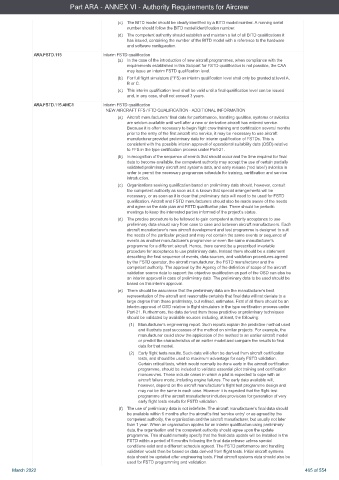Page 465 - UK AirCrew Regulations (Consolidated) March 2022
P. 465
Part ARA - ANNEX VI - Authority Requirements for Aircrew
(c) The BITD model should be clearly identified by a BITD model number. A running serial
number should follow the BITD model identification number.
(d) The competent authority should establish and maintain a list of all BITD qualifications it
has issued, containing the number of the BITD model with a reference to the hardware
and software configuration.
ARA.FSTD.115 Interim FSTD qualification
(a) In the case of the introduction of new aircraft programmes, when compliance with the
requirements established in this Subpart for FSTD qualification is not possible, the CAA
may issue an interim FSTD qualification level.
(b) For full flight simulators (FFS) an interim qualification level shall only be granted at level A,
B or C.
(c) This interim qualification level shall be valid until a final qualification level can be issued
and, in any case, shall not exceed 3 years.
ARA.FSTD.115 AMC1 Interim FSTD qualification
NEW AIRCRAFT FFS / FTD QUALIFICATION - ADDITIONAL INFORMATION
(a) Aircraft manufacturers’ final data for performance, handling qualities, systems or avionics
are seldom available until well after a new or derivative aircraft has entered service.
Because it is often necessary to begin flight crew training and certification several months
prior to the entry of the first aircraft into service, it may be necessary to use aircraft
manufacturer provided preliminary data for interim qualification of FSTDs. This is
consistent with the possible interim approval of operational suitability data (OSD) relative
to FFS in the type certification process under Part-21.
(b) In recognition of the sequence of events that should occur and the time required for final
data to become available, the competent authority may accept the use of certain partially
validated preliminary aircraft and systems data, and early release (‘red label’) avionics in
order to permit the necessary programme schedule for training, certification and service
introduction.
(c) Organisations seeking qualification based on preliminary data should, however, consult
the competent authority as soon as it is known that special arrangements will be
necessary, or as soon as it is clear that preliminary data will need to be used for FSTD
qualification. Aircraft and FSTD manufacturers should also be made aware of the needs
and agree on the data plan and FSTD qualification plan. There should be periodic
meetings to keep the interested parties informed of the project’s status.
(d) The precise procedure to be followed to gain competent authority acceptance to use
preliminary data should vary from case to case and between aircraft manufacturers. Each
aircraft manufacturer’s new aircraft development and test programme is designed to suit
the needs of the particular project and may not contain the same events or sequence of
events as another manufacturer’s programme or even the same manufacturer’s
programme for a different aircraft. Hence, there cannot be a prescribed invariable
procedure for acceptance to use preliminary data. Instead there should be a statement
describing the final sequence of events, data sources, and validation procedures agreed
by the FSTD operator, the aircraft manufacturer, the FSTD manufacturer and the
competent authority. The approval by the Agency of the definition of scope of the aircraft
validation source data to support the objective qualification as part of the OSD can also be
an interim approval in case of preliminary data. The preliminary data to be used should be
based on this interim approval.
(e) There should be assurance that the preliminary data are the manufacturer’s best
representation of the aircraft and reasonable certainty that final data will not deviate to a
large degree from these preliminary, but refined, estimates. First of all there should be an
interim approval of OSD relative to flight simulators in the type certification process under
Part-21. Furthermore, the data derived from these predictive or preliminary techniques
should be validated by available sources including, at least, the following:
(1) Manufacturer’s engineering report. Such reports explain the predictive method used
and illustrate past successes of the method on similar projects. For example, the
manufacturer could show the application of the method to an earlier aircraft model
or predict the characteristics of an earlier model and compare the results to final
data for that model.
(2) Early flight tests results. Such data will often be derived from aircraft certification
tests, and should be used to maximum advantage for early FSTD validation.
Certain critical tests, which would normally be done early in the aircraft certification
programme, should be included to validate essential pilot training and certification
manoeuvres. These include cases in which a pilot is expected to cope with an
aircraft failure mode, including engine failures. The early data available will,
however, depend on the aircraft manufacturer’s flight test programme design and
may not be the same in each case. However it is expected that the flight test
programme of the aircraft manufacturer includes provisions for generation of very
early flight tests results for FSTD validation.
(f) The use of preliminary data is not indefinite. The aircraft manufacturer’s final data should
be available within 6 months after the aircraft’s first ‘service entry’ or as agreed by the
competent authority, the organisation and the aircraft manufacturer, but usually not later
than 1 year. When an organisation applies for an interim qualification using preliminary
data, the organisation and the competent authority should agree upon the update
programme. This should normally specify that the final data update will be installed in the
FSTD within a period of 6 months following the final data release unless special
conditions exist and a different schedule agreed. The FSTD performance and handling
validation would then be based on data derived from flight tests. Initial aircraft systems
data should be updated after engineering tests. Final aircraft systems data should also be
used for FSTD programming and validation.
March 2022 465 of 554

